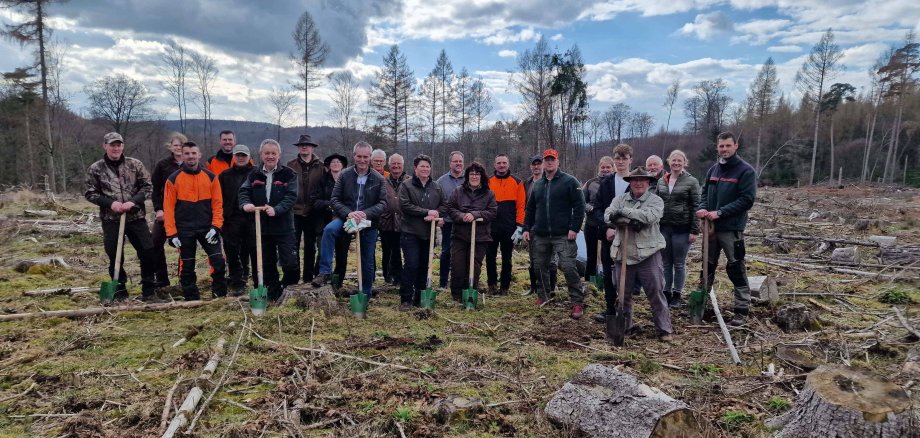Laying the foundation for the forest of the future together
Hunters, foresters and forest owners have the most diverse expectations of the native forests. But over the years, the forest has changed a lot. Drought, pests and a strong game population have taken their toll on the trees and present stakeholders with a wide variety of challenges that can only be solved together. In order to enter into dialogue with each other and to tackle problems together, the Waldeck domanial administration organised a Wild Forest Dialogue with hunting clubs, game management associations, hunting cooperatives and farmers' associations again this year.
Sweet chestnut and red oak: The forest near Diemelstadt-Rhoden currently offers plenty of space to bring new trees into the ground. Windthrow, drought and bark beetles have not only caused diseased trees and bare areas there. So it was fitting that before the dialogue began, all participants planted saplings together and thus reforested a piece of forest.
However, reforestation alone is not enough. In order to protect the trees and grow a healthy forest, the foresters have come up with various measures. "Stable mixed forests with at least four tree species are to be created on the reforestation areas. These tree species are selected to cope with a wide range of weather conditions," explained Hendrik Block, Director of the Waldeck Domanial Administration. "In order for the seedlings to grow into large trees, protective measures against browsing and shearing damage by game are necessary. For example, wood protection is fixed around every fifth tree in the reforestation area, or gated fences are installed around the areas," Block explained further.
A high game population and the restriction of the animals' habitat due to various disturbances increase the risk of browsing, fencing and shearing damage. The effect on young plants? They die, grow more slowly in height and are overgrown by competitive plants and eventually die. Mixed tree species - which are endangered by browsing - thus have a hard time asserting themselves against spruce or beech. The stable mixed forest for the future cannot develop in this way.
This is where hunters can help, explains Hendrik Block: "Through focal hunting on the reforestation areas, a reduction of high game populations and jointly coordinated hunting strategies with efficient hunting methods, the influence of game on the young plants can be reduced. Interval hunting and communal hunting, for example, offer the chance to fulfil the necessary shooting in a shorter time and thus exert less hunting pressure on the game." Forestry can support the hunters by, among other things, creating hunting corridors and grazing areas when planting new forests.
In order to find solutions for forests and game, an intensive exchange between foresters and hunters is necessary. "Thinking and acting together is imperative. Only in this way can the forest be protected and the common goals achieved," explained District Administrator Jürgen van der Horst, Chairman of the Domanial Commission. "Other issues also include visitor guidance for projects such as the Green Trails. But we are also in demand politically, for example when it comes to the hunting tax," the District Administrator continued.
Hikers, cyclists and mushroom pickers can also help to preserve the forests: Considerate behaviour, such as not leaving the paths or not visiting the forest during the main activity times of the game - at dusk. This allows the game to make better use of its habitat and uses less energy by fleeing from humans. This also leads to a reduction in the impact of game on the reforestation areas and allows the trees to grow.
The exchange is also important for the participants from hunting clubs, hunting associations, farmers' associations and hunting cooperatives. Only in this way can the expertise of the different groups be bundled and used for the preservation of the forest. "Until the different requirements and wishes are coordinated, some more talks and also changes in behaviour will be necessary. But only if everyone pulls together can the foundation be laid for the forest of the future," Hendrik Block said in conclusion.
Caption: Together we can achieve more: Before the Wild Forest Dialogue, all participants planted around 200 seedlings in an area near Diemelstadt-Rhoden.
